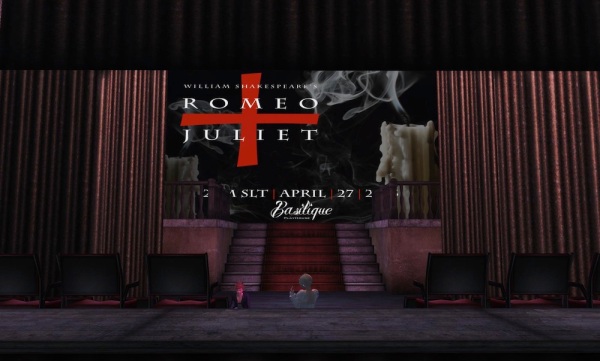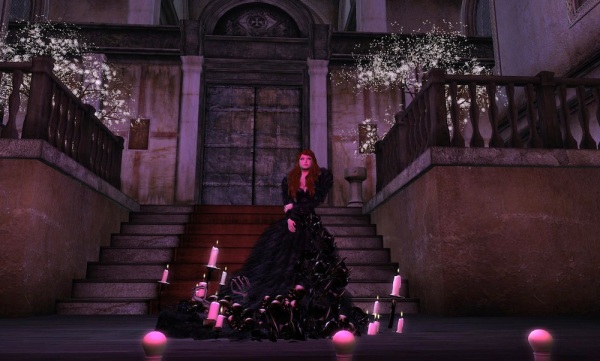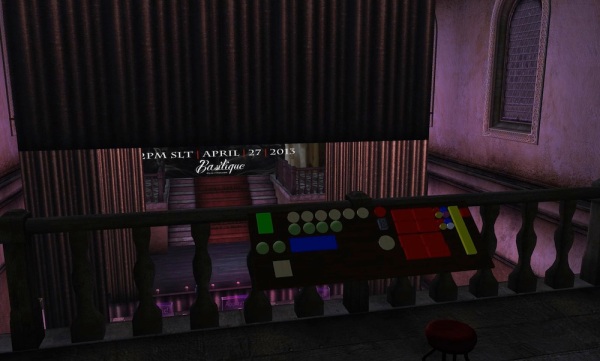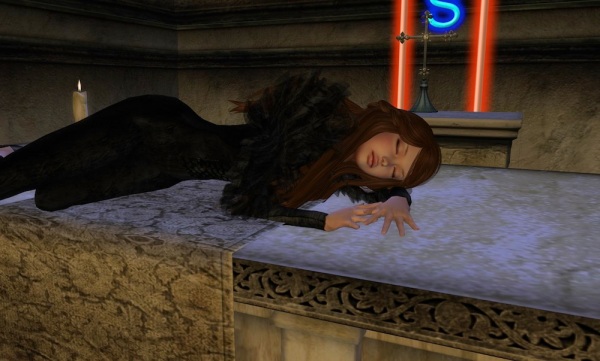
What started as a crazy idea around a kitchen table in early February is now less than a day away from becoming real. The show opens for the first time this Saturday, April 27th, 2013 at 2pm SLT at the Basilique Playhouse.
So how does one actually stage a dance number in Second Life? Well, I thought I’d document the process of how I put together one of the last numbers in our upcoming 90-minute production. Consider what I describe here and multiply it by 10, and you might get a feeling for how much work goes into this kind of performance.
This particular scene I’ll talk about takes place after Romeo has killed Tybalt, as revenge for killing his best friend Mercutio. He is banished from Verona and flees. Meanwhile, Juliet’s father, unaware she is already secretly married to Romeo, has arranged that Juliet marry the governor’s son, Paris. Desperate, Juliet goes to Friar Lawrence for advice. He then concocts a cunning plan that has Juliet faking her death by taking a potion that will put her into a deep sleep. Her family will think she’s died, and will put her in the family tomb. In the meantime, the Friar will send a message to Romeo informing him of the plan. Romeo will come to the church and then take her away with him to Mantua. Unfortunately, the message doesn’t get through, and Romeo hears of Juliet’s untimely “death”, and ends up joining her in more ways than one…

For our production, we needed to have a way of showing Juliet taking the potion and ending up in the church all in one scene. It’s the seventh scene of nine in total.
My first step is selecting the music. For this number, we chose Moby’s “Sleep Alone”. It has the right melancholy mood and was a unique addition to the other songs which range from jazz to rock to folk to classical.
After selecting the music, we started building the scene. We built all the scenes for Romeo and Juliet and this image shows the entrance to the church where Juliet enters to take the potion.

The Playhouse itself was custom-built with this production in mind. The sets are a mix of furnishings, building parts and backdrops made from inworld photographs. For quick changes, the sets are all powered by rezzers that Harvey built specifically for the performance. Below is the control panel that is used to launch everything from the sets, the backdrops, lighting, curtains and special effects like fading buildings and smoke.

For costumes, we went with a ‘40s theme, mainly because that’s the theme of our club, the Basilique. Because this is actually a dream sequence, I decided to dress Juliet in a fantastic costume made of candles and skulls made by PurpleMoon.

Next comes choreography. I first cut my teeth setting SL dances to music with our Burlesque show, but this is considerably more complex. For the Burlesque Show, we mainly stood in one place on stage, did the number, and that was it. For Romeo and Juliet, we actually need to tell a story through choreography. So getting Juliet from centre stage to lying on the altar asleep, while dancing, is a challenge in itself.
I selected dances from MyAnimation’s new Ballet Series and created a playlist in a Dance Hud. The playlist must be set in perfect time with the music to give the impression of a fluid and meaningful performance.

Frustrated with Henmation’s Dance Control HUD, which managed through the Burlesque show, but has buckled under the strain of what we’re now doing, Harvey developed his own proprietary dance HUD, which is a speed demon under the toughest conditions. Here is the playlist I created in Google Docs, that I then use to upload to Harvey’s HUD.

So what I do essentially, is chop the song into bits. After doing this, I might get about 6 or 7 natural breaks where the song changes direction – a prelude, a chorus, a verse, an interlude, etc… That’s the best time for a transition from one dance to another. After cutting the song up, I then play that bit over and over again, while trying different dances to it. Once I find a few that fit, I’ll make a notes and then move on to the next bit and repeat the process. Once that’s done, I make a playlist.
Once I have the best 6 or 7 dances that fit the song, I then block the choreography. This involves moving from one place to another to tell the story of the scene. We’ve used all sorts of approaches to this, from double-click teleports set to “move”, to automated stage movers that move you using a series of landmarks. While both work well, for this number I’m walking from place to place as it allows a little more spontaneity and control, which I like.
Finally, once I’ve got all the playlist and blocking done, then I practice the number. Over and over again. I’d say it takes at least half a dozen times to get to the point where I feel completely comfortable with it.
And that’s just a simple solo scene. Mixing it up with others, blending in couple dances, fight and furniture animations all adds to the fun and complexity. And that’s just the dancing parts.
Once the scenes are set, we need to make sure we have the streaming appropriate cued, the lighting right, and the curtains opening and closing on time.
We’ve written our own poetry inspired by the play, and I’ve read them and recorded them as voiceovers.
For this production, we’ve also experimented with a few special effects we haven’t seen before. For example, we’ll be delivering actual lines from the play in local chat while the dance numbers are going, using an automatic talking device. Yes, we actually went through every scene of the play and pulled out the lines that best fit the story we were trying to tell, and how we were trying to tell it.
The music too, has been a wonderful journey of curation. Not only have we chosen 10 songs for the dance numbers, but because we need time between songs to change sets, costumes, and get into place, we also have selected 8 additional songs that help to tell this seminal story. It’s such a great range of music, featuring songs performed by Nat King Cole, The Black Eyed Peas, Ella Fitzgerald, Michael Buble, Queen, Jack Black, Papa Roach, Cowboy Junkies, Lily Allen, Josh Groban, The Swell Season, Duran Duran, Coldplay, Indigo Girls, and of course, Moby. We’ve even thrown a little London Symphony Orchestra and Enno Morricone into the mix.
So it’s been a fantastic journey and so much fun. Working so closely together with Harvey on this has been another incredibly creative and enjoyable exercise in stagecraft, writing, music choice, costumes, choreography and technology. Ame Dovgal (who plays Mercutio) has been super-trooper, planning and leading 3 dance numbers of her own, every one of them fantastic. She’s also in 2 other numbers playing Juliet. Cloe Nyn (playing Paris) and Belice Benoir (playing Tybalt) from the Amouresque have been a pleasure to work together with, and have contributed loads to rounding out the edges of the performance to give us a complete cast. Purdie Silkamour wrote most of the verse and was instrumental in brainstorming with us in the early stages of production. I play Romeo, but also play Juliet at the same time for one really busy number (the meeting), and in the proposal scene, and Juliet’s final “death” scene.
I do hope you’ll join us for one of our performances. We’ll be opening on the 27th of April, Saturday at 2pm. We will only have 30 seats available to keep lag down, so if you intend to see the show, please arrive early.
We hope to see you there!

Wow Becky!!!
This is incredible! It’s just remarkable how much you’ve put into this production. I love seeing Harvey’s “Rezzer” in that it looks so much like a theatrical sound or light console and reminds you of how much kinship there is between your ambitious virtual performance and an RL theatrical production.
I have some commitments on Saturday and might not be able to get there myself, but I will if I can and I’ll definitely start Tweeting, Pinning, etc, the news as soon as I finish typing this comment! 🙂
I do hope you’ll have a “Performance Report” with some pix or vids and your thoughts on actually pulling the whole thing off once it’s done.
Congratulations!!!
Hello Van! We opened up to some wonderful responses and now have 4 dates and time set for May. Hopefully you can make some of them: http://canarybeck.com/2013/05/01/romeo-and-juliet-opening-night-reviews-are-in/
I have been to many theater performances in Second Life. I have been to many ballets in Second Life. I have been to a ton of concerts, live and… well, not that live! All were the result of a considerable effort. SL is, nevertheless, merciless to this type of performance, and it’s quite frequent for the audience to get distracted by the oddity of the participating avatars’ behavior. Synchronization is virtually impossible. Taking into account all of SL’s quirks, Romeo an Juliet was an amazing performance. It’s visuals were beyond beautiful with a clean, uncluttered set elegantly decorated and lighted. The mix between text, dance and music was well balanced. The intermissions were a bit too long, but I gather this was due to the antecipation everyone felt to watch the next scene! The coordination needed to change the set, the poseballs, to get the music to enter on cue was extraordinary. To all who believe SL is not a pace for this type of performances… it CAN be done! I was told that there will be a few more performances in May, so, i you get a chance, do attend. It’s worth it! Huckleberry Hax wrote a great review post in his blog about this play where he said it was an hour and a half long. My reaction was “it was???”. It sure didn’t feel like it! Congratulations to your, Becky, to Harvey and to all the actors. It was amazing!
Thank you so much for your kind words Lizzie. We are so lucky to have opened to a supportive group, and to come away with very little in the way of technical hiccups was indeed extraordinary!
Great post Becky! You are an amazing talent. Hugs